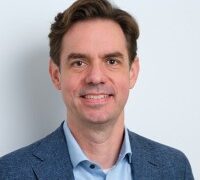The power of paradoxical thinking
IMD’s Andrew Sharman sits down with Amy Walters Cohen, whose award-winning book Ruthlessly Caring challenges conventional leadership – and offers a paradoxical path forward in a world in flux....
November 3, 2025 in Sustainability
In this Masterclass hosted with the World Business Council on Sustainable Development, Professors Michael Wade and Julia Binder discuss the benefits of bringing together AI and sustainability thinking....
The World Economic Forum’s Global Risks Report 2025 identifies two forces that currently dominate business conversations about future risks: the accelerating urgency of the climate crisis and the race toward digital transformation driven by artificial intelligence. But what happens when these two megatrends collide?
This question framed IMD’s recent masterclass, “Greening AI: What every business leader needs to know,” hosted in partnership with the World Business Council on Sustainable Development (WBCSD). The session, led by Michael Wade and Julia Binder, unpacked how AI, a technology that comes with a substantial environmental cost, might also become one of the most powerful tools for driving sustainability.
“AI and sustainability are the two great transformations of our time, yet most companies treat them as entirely separate,” said Wade. Digital teams typically sit on one side of the organization with sustainability teams on another. The opportunity lies in bringing them together.
This integration begins by understanding AI’s environmental footprint. Training advanced models consumes staggering amounts of power and water. As these models become embedded in everyday operations, inference (i.e., using the models) is now starting to rival training in energy intensity. Last year, data centers consumed about 1.5% of the world’s electricity demand, a share set to nearly double by 2030, according to the International Energy Agency.
“The first step is to acknowledge that AI isn’t automatically good,” said Wade. “Its impact depends on how we deploy it.”
Introducing the presentation, the panel moderator, WBCSD’s Maarten Dirks asked participants what they feared most about AI’s footprint. The consensus was clear: energy consumption loomed largest ahead of other risks like “water,” “uncontrollable,” or “inefficiency.” A second poll revealed that most participants rated their organizations at the “intermediate” and “novice” stages of integrating AI with sustainability, a telling sign that awareness is high, but maturity remains low.

“You can’t reduce what you can’t see,” said Binder. “Most corporate emissions hide in Scope 3, those indirect emissions across sprawling supply chains.” Here, AI can act as a powerful flashlight.
She pointed to AI-enabled transparency tools that can map complex value chains, track materials, and spot hotspots invisible to traditional reporting. One striking example is the HolyGrail initiative, which embeds digital watermarks on packaging to enable recyclers to instantly identify materials and sort them for higher-value recycling rather than wasteful downcycling.
The food industry also offers some telling insights. When the ethical chocolate brand Tony’s Chocolonely used AI to analyze its “bean-to-bar” supply chain, it discovered that the largest contributor to its footprint wasn’t packaging or logistics, but dairy. That discovery led to a reformulation toward darker chocolate and milk substitutes. “AI helps you find the counterintuitive levers,” Wade noted. “That’s where the real progress happens.”
Once you can see impacts clearly, the next challenge is acting on them.
Once you can see impacts clearly, the next challenge is acting on them. Binder highlighted how AI already powers meaningful reductions in resource use, from optimizing shipping routes at companies like Maersk to enabling precision agriculture that targets water, fertilizer, and pesticides only where needed.
That principle extends beyond operations to behavior. “When people can see their energy use in real time, they change how they act,” Wade said, citing studies where real-time feedback from smart meters led households to cut consumption significantly. He compared it to the way wearables like the Oura ring change personal habits: “Visibility leads to action.”
The speakers also urged companies to dematerialize wherever possible, replacing atoms with bits. “Every time you substitute a physical process with a digital one, you’re likely cutting emissions,” said Wade. Even data centers, notorious for their energy use, can be part of the solution when their waste heat is redirected to warm municipal buildings or swimming pools, for instance.
If seeing and acting are the first two steps, scaling is the true test.
If seeing and acting are the first two steps, scaling is the true test. “We already have the tools to reduce emissions,” said Binder. “The question is: how do we make what works scale fast enough?”
She pointed to examples of AI-driven scaling: drones that use machine learning to restore forests by identifying optimal planting sites and seed mixes; digital platforms like Too Good To Go that match surplus food with local demand, now preventing millions of tons of waste globally; and AI applications that help balance renewable-heavy energy grids in real time.
For Wade, this system-level view is essential. “We tend to think of sustainability in silos – energy, transport, agriculture – but AI can coordinate across those boundaries,” he said. “That’s how small improvements turn into real transformation.”

Both Wade and Binder cautioned against what they called “AI solutionism. “Ask first: do we even need AI for this?” Wade urged. Simpler tools, traditional analytics, or organizational change can sometimes yield faster and cleaner results. “The greenest computation,” he said, “is the one you don’t run.”
Binder emphasized materiality, adding, “It’s easy to optimize the wrong thing because it looks good in a report. You can’t let the shiny pilot distract from where your biggest impacts lie.”
Both agreed that data quality is still the biggest bottleneck. “Everyone wants fancy models,” Wade said. “But the hard work is building clean, trustworthy data streams. Once you have that, the rest is easy.”
Finally, there’s the industry’s own reckoning. Despite ambitious climate pledges, many technology giants are seeing absolute emissions rise as AI scales. “The pressure to decarbonize won’t only come from investors or consumers,” Wade observed. “It will come from the sheer cost of energy and water.”
AI is a double-edged technology: energy-hungry and powerful in equal measure.
The professors closed the session with practical advice for the months ahead. Companies should start by mapping their true hotspots: not just where emissions are reported, but where they originate. They should then pick a small number of AI-powered interventions (route optimization, energy load management, or precision resource use, for example) and test them with clear baselines and measurable outcomes.
Most importantly, they should bring their digital and sustainability teams together, with shared KPIs that measure both performance and impact. “When these agendas finally converge,” said Binder, “we’ll unlock the real value of AI, not just for productivity, but for the planet.”
AI is a double-edged technology: energy-hungry and powerful in equal measure. The challenge for business isn’t whether to use it, but how to use it wisely. As Wade put it, “Technology doesn’t solve the sustainability problem by itself. But applied with purpose, it can accelerate solutions faster than anything else we have.”

Professor of Sustainable Innovation and Business Transformation, IMD

TONOMUS Professor of Strategy and Digital, IMD

Education Director (Digital), WBCSD
September 1, 2025 • by Andrew Sharman , Amy Walters Cohen in I by IMD Book Club • 5 min read
IMD’s Andrew Sharman sits down with Amy Walters Cohen, whose award-winning book Ruthlessly Caring challenges conventional leadership – and offers a paradoxical path forward in a world in flux....
July 30, 2025 • by Julia Binder, Cass R. Sunstein in I by IMD Book Club • 5 min read
In his book Climate Justice: What Rich Nations Owe the World – and the Future, Cass R Sunstein delivers a timely exploration of the moral and practical obligations that wealthy nations have...
June 20, 2025 • by Knut Haanaes, Martin Reeves in I by IMD Book Club • 5 min read
BCG’s Martin Reeves traces the messy human journey behind one of tech’s most contagious features – and what it reveals about innovation, behavior, and unintended consequences. ...
May 30, 2025 • by Brian Evergreen, Stefan Michel in I by IMD Book Club • 5 min read
Brian Evergreen shares radical insights from his book Autonomous Transformation: Creating a More Human Future in the Era of AI with IMD’s Stefan Michel....
May 1, 2025 • by Albrecht Enders, Christoph Glaser in I by IMD Book Club • 8 min read
Mindfulness expert Christoph Glaser shares insights from Breathe, his best-selling book on how simple, breath-based techniques can reduce stress, sharpen focus, and help leaders stay centred under pressure....
March 28, 2025 • by Jim Pulcrano, Matthew C Weinzierl, Brendan Rosseau in I by IMD Book Club • 7 min read
Authors of Space to Grow, Matthew Weinzierl and Brendan Rosseau, tell IMD's Jim Pulcrano that one of the central aims of their book is to inspire industries, businesses and individuals...
February 26, 2025 • by Heather Cairns-Lee, Eugene Sadler-Smith in I by IMD Book Club • 8 min read
Heather Cairns-Lee from IMD and leadership expert Eugene Sadler-Smith discuss why intuitive intelligence is a critical skill in a data-driven world....
January 17, 2025 • by Julia Binder, Knut Haanaes in I by IMD Book Club • 7 min read
IMD's Julia Binder and Knut Haanaes explore how aligning purpose with profit, fostering innovation, and building resilience, can help companies embed sustainability into business strategy....
November 30, 2024 • by Andrew Sharman , Susan Goldsworthy in I by IMD Book Club • 7 min read
This Book Club discussion explored actionable steps for individuals and companies to address the 'crisis of well-being'....
November 1, 2024 • by Gina Battye, Alexander Fleischmann in I by IMD Book Club • 8 min read
Gina Battye shares her advice on how to achieve long-term cultural change....
Explore first person business intelligence from top minds curated for a global executive audience